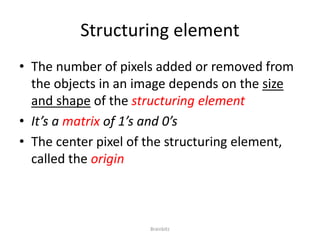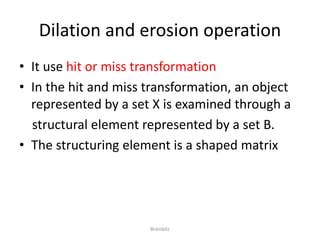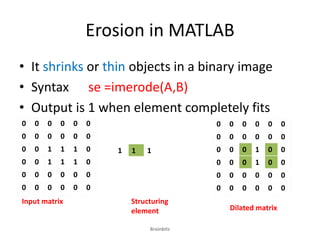Dilation and erosion
- 1. MORPHOLOGICAL OPERATIONS Dilation AND Erosion Brainbitz
- 2. Morphological operation âĒ It is a collection of non-linear operations related to the shape or morphology of features in an image. âĒ ie , we process images according to its shape âĒ 2 fundamental operations ïDilation ïErosion Brainbitz
- 3. DILATION AND EROSION âĒ Dilation adds pixels to the boundaries of objects in an image âĒ Erosion removes pixels on object boundaries Brainbitz
- 4. DILATION âĒ It grows or thicken objects in a binary image âĒ Thickening is controlled by a shape referred to as structuring element âĒ Structuring element is a matrix of 1âs and 0âs Brainbitz
- 5. Brainbitz
- 6. Brainbitz
- 7. Opening and Closing operations âĒ Opening ï An Erosion followed by a dilation âĒ Closing ï A dilation followed by an erosion Brainbitz
- 8. Brainbitz
- 9. Brainbitz
- 10. Structuring element âĒ The number of pixels added or removed from the objects in an image depends on the size and shape of the structuring element âĒ Itâs a matrix of 1âs and 0âs âĒ The center pixel of the structuring element, called the origin Brainbitz
- 11. Origin of a Diamond-Shaped Structuring Element Brainbitz
- 12. Dilation and erosion operation âĒ It use hit or miss transformation âĒ In the hit and miss transformation, an object represented by a set X is examined through a structural element represented by a set B. âĒ The structuring element is a shaped matrix Brainbitz
- 13. Cont. âĒ Miss ïĻ No changes âĒ Hit ïĻ at least one pixel matches =>The origin is replaced by 1 0 0 0 0 0 0 0 0 0 0 0 0 0 0 1 1 1 0 0 0 1 1 1 0 0 0 0 0 0 0 0 0 0 0 0 0 0 0 0 0 0 0 0 0 0 0 0 0 0 1 1 1 1 1 0 1 1 1 1 1 0 0 0 0 0 0 0 0 0 0 0 0 1 1 1 Input matrix Structuring element Dilated matrix Brainbitz
- 14. Dilation in MATLAB âĒ Syntax Y = imdilate(A,B) âĒ A ïĻ input image âĒ B ïĻ Structuring element âĒ Y ïĻDilated image Brainbitz
- 15. Structuring element in MATLAB âĒ They can be easily created using âstrelâ function se = strel ( shape , parameters ) âĒ Shape can be â diamond â , â square â , â disk â , â line â etc. Brainbitz
- 16. Erosion in MATLAB âĒ It shrinks or thin objects in a binary image âĒ Syntax se =imerode(A,B) âĒ Output is 1 when element completely fits 0 0 0 0 0 0 0 0 0 0 0 0 0 0 1 1 1 0 0 0 1 1 1 0 0 0 0 0 0 0 0 0 0 0 0 0 0 0 0 0 0 0 0 0 0 0 0 0 0 0 0 1 0 0 0 0 0 1 0 0 0 0 0 0 0 0 0 0 0 0 0 0 1 1 1 Input matrix Structuring element Dilated matrix Brainbitz
- 17. Dilation program BW = zeros(9,10); BW(4:6,4:7) = 1 SE = strel('square',3) BW2 = imdilate(BW,SE) Brainbitz
- 18. Brainbitz
- 19. Brainbitz
- 20. Questions Brainbitz âĒ Perform dilation and erosion




















